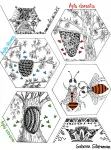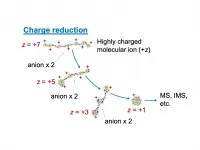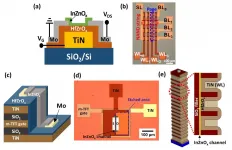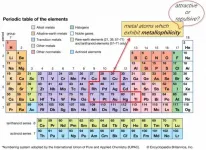FGF23 hormone from red blood cell precursors promotes hematopoietic stem cell mobilization
Discovery expected to contribute towards more effective methods of harvesting stem cells from bone marrow donors.
2021-01-19
(Press-News.org) A Kobe University research group including graduate student ISHII Shinichi and Associate Professor KATAYAMA Yoshio (both of the Department of Hematology, Graduate School of Medicine) have discovered that fibroblast growth factor-23 (FGF23) produced by erythroblasts (cells that are the precursors of red blood cells) promotes the movement (mobilization) of hematopoietic stem cells (*1) into the peripheral blood. Up until now, FGF23 has been known for the role it plays in the kidneys as a hormone which regulates phosphate concentrations throughout the body.
It is hoped that this discovery will enable new strategies to be developed for harvesting hematopoietic stem cells from bone marrow transplant donors.
These research results were given advanced online publication in the American scientific journal 'blood' on December 23, 2020, prior to the printed version.
Main Points
FGF23 is mainly produced by bone-embedded osteocytes, however this research revealed that the hormone is also produced by erythroblasts located in the bone marrow.
This erythroblastic production of FGF23 was triggered by low oxygen levels (hypoxia) in the bone marrow, which resulted from G-CSF (*2) administration. G-CSF is utilized medically to induce cell mobilization.
It was revealed that this high concentration of FGF23 in the bone marrow promoted mobilization of hematopoietic stem cells by suppressing the function of chemokine receptors, which retain these cells in the bone marrow.
Research Background
According to the textbook definition, fibroblast growth factor-23 is a hormone that is produced by bone-embedded osteocytes and regulates phosphate homeostasis in the kidneys. It is widely known that overproduction of FGF23 results in hereditary hypophosphatemic rickets (otherwise known as vitamin D-resistant rickets) and this can be treated with antibody-based drugs that target FGF23. In recent years, FGF23 has also been used as an indicator of chronic renal failure. However, the effect of FGF23 on bone marrow cells had not yet been clarified.
In order to perform bone marrow transplants, it is necessary to collect hematopoietic stem cells from a donor. Nowadays, G-CSF and Plerixafor (which is a CXCR4 chemokine receptor antagonist) are widely administered to donors in order to cause hematopoietic stem cells to be released from the bone marrow and into the peripheral blood. This makes it possible to harvest the stem cells from the blood, which is safer and less invasive than harvesting them from the bone marrow. However up until now, the mechanism behind this mobilization was only partially understood.
Research Findings
First of all, the research group discovered that when G-CSF was administered to mice, production of FGF23 in the bone marrow greatly increased. Subsequent cell analysis revealed that FGF23 was produced by the majority of erythroblasts inside the bone marrow. Erythroblasts are the precursors of red blood cells.
G-CSF administration and the subsequent stimulation of the sympathetic nerves resulted in low oxygen levels inside the bone marrow. It became clear that FGF23 was ejected from the erythroblasts into the bone marrow as a result of this induced hypoxia. A surprisingly high concentration of FGF23 was released in the bone marrow as a result of G-CSF administration (approx. 20,000 times higher than the concentration in the peripheral blood). It was subsequently revealed that this elevated concentration weakened the anchor molecules (in this case, the chemokine receptor CXCR4) which are responsible for the bone marrow's retention of hematopoietic stem cells, thus causing these stem cells to move (mobilize) out of the bone marrow and into the peripheral blood.?
Further Developments
It is necessary for bone marrow transplant donors to receive a series of injections beforehand that cause hematopoietic stem cells to be released into the peripheral blood so that these stem cells can then be harvested. However, in around 10% of cases this doesn't occur correctly (insufficient mobilization). These research findings are expected to contribute towards resolving this issue, hopefully enabling new strategies to be created.
INFORMATION:
Glossary
1. Hematopoietic stem cells: These are cells in the bone marrow that are responsible for producing blood cells.
2. G-CSF: G-CSF stands for granulocyte colony-stimulating factor. It is used medicinally to stimulate an increase of neutrophils, which are an essential part of the body's immune system.
Journal Information
Title:
" FGF23 from erythroblasts promotes hematopoietic progenitor mobilization "
DOI:10.1182/blood.2020007172
Authors:
Shinichi Ishii, Tomohide Suzuki, Kanako Wakahashi, Noboru Asada, Yuko Kawano, Hiroki Kawano, Akiko Sada, Kentaro Minagawa, Yukio Nakamura, Seiya Mizuno, Satoru Takahashi, Toshimitsu Matsui, Yoshio Katayama
Journal:
Blood (The official journal of the American Society of Hematology)
[Attachments] See images for this press release:
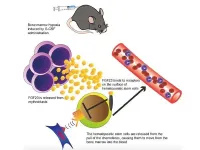
ELSE PRESS RELEASES FROM THIS DATE:
2021-01-19
It is early in the morning. Ebi and his colleagues try not to twitch as they stare intently at a rectangular box filled with sugary treats. These aren't for them, but for the honey bees that they study. The tiny buzzers toggle between the sugar 'feeder' and the hive, which are a few metres apart. Interestingly, the bees that visit the feeder aren't secretive about this new found food source. They graciously advertise its location to their nest mates and over time more bees are seen buzzing to the feeder.
This behavior has been observed and researched for decades; but still, the question of how bees communicate within the noisy quarters ...
2021-01-19
Mass spectrometers (MS) have become essential tools in chemistry and biology laboratories. The ability to quickly identify the chemical components in a sample allows them to take part in a diverse array of experiments, including radiocarbon dating, protein analysis, and monitoring drug metabolism.
MS instruments work by giving the analyte molecules an electric charge, and shooting them through a region of space with a uniform electric field, which curves their trajectory into a circle. The radius of the circle, which depends on the ratio of the molecule's mass to its charge, is detected and compared with known samples. Because the method can only measure this ratio, not the mass itself, excess charges can lead to inaccurate or ambiguous results.
Now, a team of researchers lead ...
2021-01-19
"Stripy zebra, spotty leopard, ...". Kids never become bored pinpointing animals based on their unique body patterns. While it is fascinating that living creatures develop distinct patterns on their skin, what may be even more mysterious is their striking similarity to the skin of frozen liquid metals.
Pattern formation is a classic example of one of nature's wonders that scientists have pondered for centuries. Around 1952, the famous mathematician Alan Turing (father of modern computers) came up with a conceptual model to explain the pattern formation process of a two-substance system. Such patterns are also called Turing patterns thereafter.
Pattern formation is also commonly adopted by manmade systems and this is especially true in the ...
2021-01-19
Fungi are among the world's oldest and most tenacious organisms. They are now showing great promise to become one of the most useful materials for producing textiles, gadgets and other construction materials. The joint research venture undertaken by the University of the West of England, Bristol, the U.K. (UWE Bristol) and collaborators from Mogu S.r.l., Italy, Istituto Italiano di Tecnologia, Torino, Italy and the Faculty of Computer Science, Multimedia and Telecommunications of the Universitat Oberta de Catalunya (UOC) has demonstrated that fungi possess ...
2021-01-19
The compulsory collection of DNA being undertaken in some parts of the world is not just unethical, but risks affecting people's willingness to donate biological samples and thus contribute to the advancement of medical knowledge and the development of new treatments, says a paper in the European Journal of Human Genetics, published online* today [18 January 2021].
Citing abuses being carried out in China, Thailand, and on the US/Mexico border, the authors1 call on scientific journals to reexamine all published papers based on databases that do not meet accepted standards of ethical approval, and demand an end to collaborations between academic institutions worldwide and those in countries carrying out unethical DNA collections. ...
2021-01-19
As we enter the era of superintelligence and hyper-connected Fourth Industrial Revolution, the importance of high-density and high-performance memory is greater than ever. Currently, the most widely used NAND flash memory has issues of high power consumption, slow operation speed, and vulnerability to repetitive use since it relies on the charge trap effect to store information. To this, a POSTECH research team has recently demonstrated a ferroelectric memory that exceedingly surpasses the performance of the conventional flash memory in terms of operation speed, power consumption, and device reliability.
A POSTECH research team - led by Professor Jang-Sik Lee, and Ph.D. candidates Min-Kyu Kim and Ik-Jyae Kim of the Department ...
2021-01-19
Maxwell equations govern the evolution of electromagnetic fields with light being a particular solution of these equations in spaces devoid of electric charge. A new study published in EPJ C by Alexei Morozov and Nikita Tselousov, from the Moscow Institute of Physics and Technology and the Institute of Transmission Problems, Russia, respectively, details peculiar solutions to the Maxwell equations--so-called Maxwell knots. The research could have applications in the fields of mathematical physics and string theory.
"We usually think of light as the plane waves. It was a breakthrough when ...
2021-01-19
Two giant radio galaxies have been discovered with South Africa's powerful MeerKAT telescope. These galaxies are thought to be amongst the largest single objects in the Universe. The discovery has been published today in Monthly Notices of the Royal Astronomical Society.
Whereas normal radio galaxies are fairly common, only a few hundred of these have radio jets exceeding 700 kilo-parsecs in size, or around 22 times the size of the Milky Way. These truly enormous systems are dubbed 'giant radio galaxies'.
Despite the scarcity of giant radio galaxies, the authors found two of these cosmic beasts in a remarkably small patch of sky.
Dr Jacinta Delhaize, a Research Fellow at the ...
2021-01-19
Scientists from the Leibniz Institute for Zoo and Wildlife Research (Leibniz-IZW) have found that interacting with other males is more "stressful" for low-ranking than for high-ranking male spotted hyenas. This restricts the time and energy low-ranking males can invest in courting the most desirable females and is therefore a key factor for their lower reproductive success than their high-ranking rivals. This mechanism seems to be more important in determining the number and quality of offspring than physical traits such as attractiveness and fighting ability. These insights were possible owing to a combination of extensive field and lab work - over 20 years of searching and identifying thousands ...
2021-01-19
A research team led by Professor Chi-Ming CHE and Dr Jun YANG, from the Research Division for Chemistry and Department of Chemistry at the Faculty of Science of the University of Hong Kong, has resolved a long-standing fundamental problem in the field of metal-metal closed-shell interaction. This work has been published in the journal Proceedings of the National Academy of Sciences (PNAS).
Metal-Metal closed-shell interaction, also known as metallophilicity, has a huge impact in diverse fields of chemistry, such as supramolecular chemistry and organometallic chemistry. Early reports on metallophilicity could be traced back to the 1970s. Many leading theoretical chemists ...
LAST 30 PRESS RELEASES:
[Press-News.org] FGF23 hormone from red blood cell precursors promotes hematopoietic stem cell mobilization
Discovery expected to contribute towards more effective methods of harvesting stem cells from bone marrow donors.

